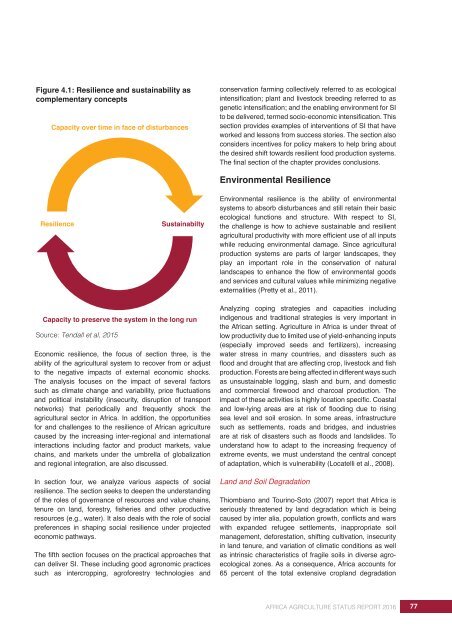AFRICA AGRICULTURE STATUS REPORT 2016
AASR-report_2016-1
AASR-report_2016-1
You also want an ePaper? Increase the reach of your titles
YUMPU automatically turns print PDFs into web optimized ePapers that Google loves.
Figure 4.1: Resilience and sustainability as<br />
complementary concepts<br />
Capacity over time in face of disturbances<br />
conservation farming collectively referred to as ecological<br />
intensification; plant and livestock breeding referred to as<br />
genetic intensification; and the enabling environment for SI<br />
to be delivered, termed socio-economic intensification. This<br />
section provides examples of interventions of SI that have<br />
worked and lessons from success stories. The section also<br />
considers incentives for policy makers to help bring about<br />
the desired shift towards resilient food production systems.<br />
The final section of the chapter provides conclusions.<br />
Resilience<br />
Sustainabilty<br />
Environmental Resilience<br />
Environmental resilience is the ability of environmental<br />
systems to absorb disturbances and still retain their basic<br />
ecological functions and structure. With respect to SI,<br />
the challenge is how to achieve sustainable and resilient<br />
agricultural productivity with more efficient use of all inputs<br />
while reducing environmental damage. Since agricultural<br />
production systems are parts of larger landscapes, they<br />
play an important role in the conservation of natural<br />
landscapes to enhance the flow of environmental goods<br />
and services and cultural values while minimizing negative<br />
externalities (Pretty et al., 2011).<br />
Capacity to preserve the system in the long run<br />
Source: Tendall et al, 2015<br />
Economic resilience, the focus of section three, is the<br />
ability of the agricultural system to recover from or adjust<br />
to the negative impacts of external economic shocks.<br />
The analysis focuses on the impact of several factors<br />
such as climate change and variability, price fluctuations<br />
and political instability (insecurity, disruption of transport<br />
networks) that periodically and frequently shock the<br />
agricultural sector in Africa. In addition, the opportunities<br />
for and challenges to the resilience of African agriculture<br />
caused by the increasing inter-regional and international<br />
interactions including factor and product markets, value<br />
chains, and markets under the umbrella of globalization<br />
and regional integration, are also discussed.<br />
In section four, we analyze various aspects of social<br />
resilience. The section seeks to deepen the understanding<br />
of the roles of governance of resources and value chains,<br />
tenure on land, forestry, fisheries and other productive<br />
resources (e.g., water). It also deals with the role of social<br />
preferences in shaping social resilience under projected<br />
economic pathways.<br />
The fifth section focuses on the practical approaches that<br />
can deliver SI. These including good agronomic practices<br />
such as intercropping, agroforestry technologies and<br />
Analyzing coping strategies and capacities including<br />
indigenous and traditional strategies is very important in<br />
the African setting. Agriculture in Africa is under threat of<br />
low productivity due to limited use of yield-enhancing inputs<br />
(especially improved seeds and fertilizers), increasing<br />
water stress in many countries, and disasters such as<br />
flood and drought that are affecting crop, livestock and fish<br />
production. Forests are being affected in different ways such<br />
as unsustainable logging, slash and burn, and domestic<br />
and commercial firewood and charcoal production. The<br />
impact of these activities is highly location specific. Coastal<br />
and low-lying areas are at risk of flooding due to rising<br />
sea level and soil erosion. In some areas, infrastructure<br />
such as settlements, roads and bridges, and industries<br />
are at risk of disasters such as floods and landslides. To<br />
understand how to adapt to the increasing frequency of<br />
extreme events, we must understand the central concept<br />
of adaptation, which is vulnerability (Locatelli et al., 2008).<br />
Land and Soil Degradation<br />
Thiombiano and Tourino-Soto (2007) report that Africa is<br />
seriously threatened by land degradation which is being<br />
caused by inter alia, population growth, conflicts and wars<br />
with expanded refugee settlements, inappropriate soil<br />
management, deforestation, shifting cultivation, insecurity<br />
in land tenure, and variation of climatic conditions as well<br />
as intrinsic characteristics of fragile soils in diverse agroecological<br />
zones. As a consequence, Africa accounts for<br />
65 percent of the total extensive cropland degradation<br />
<strong>AFRICA</strong> <strong>AGRICULTURE</strong> <strong>STATUS</strong> <strong>REPORT</strong> <strong>2016</strong><br />
77


